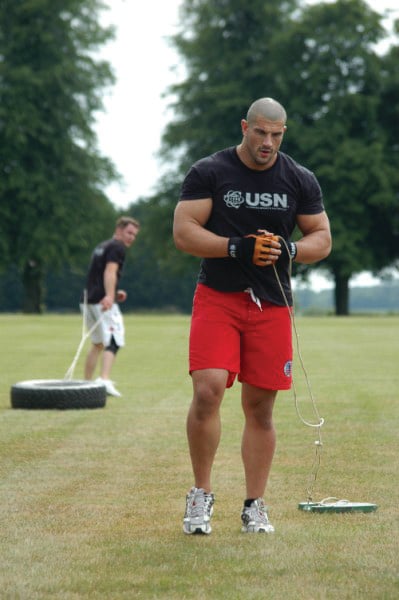
Issue 019
November 2006
Sled training for combat athletes
By Alex Gold
Introducing the sled
A dragging sled is a metal plate with a turn-up at one end, with a loop to attach straps on the front edge and a loading pin in the middle so you can add weight. The straps are usually three or four metres long and can be attached to a belt or harness or even held in the hands. The user then drags the sled along the ground. A tyre or pallet can also be used in place of a sled, although adjusting loading can be more difficult and an advantage of a well-designed sled is that it will do minimal damage to the ground, unlike the alternatives mentioned. Sounds simple, and the design is indeed uncomplicated, but this tool can take your training to a whole new level!
The sled can be used in many different ways to improve strength or fitness and is a very popular tool for those involved in MMA.
Advantages of using a sled
There are many advantages to using a sled. Depending on your goals, there are normally alternative means to achieve the same training effect, but in some cases using a sled is superior. For instance instead of using a sled for sprints you could try using a weighted backpack. In this case the sled would be superior as the weight is not bouncing on your back interfering with your technique, nor is it creating undue stress to the joints (especially the knees).
A sled can also increase the difficulty of sprint training, increasing the positive adaptations made by the body and teaching you to ‘dig deep’ and keep fighting against the sled (despite the fact you can’t ever win!)
If you attach the sled to the body with a belt, it will ensure that you are using correct abdominal bracing, meaning you must tense the abs and keep tight through the torso. With the belt around the waist, every step you take will cause the belt to try and push into the abdominal wall. Bracing the abs will counteract this force.
This is a very important skill for fighters or anyone in a sport where contact or other external force is applied through the body while breathing is being challenged. When first training with the sled most people will find that their abdominals are challenged as much as their legs.

How to use the sled
A sled can be used on most surfaces, including but not limited to:
· Grass
· Concrete
· Astroturf
· Rubber running tracks
A correctly designed sled will do no damage to any of the above surfaces, so strap one on and get training!
The first way to train with the sled is to simply walk.with it. This is a great exercise for people who are a bit far off from optimal fitness, or as an easy workout to get some blood flowing through the legs. Distance and weight will depend on the goals, fitness and strength of the individual, but a 200m course followed by a short rest repeated multiple times would be one idea of how to train just walking with the sled.
Believe it or not, this method is harder than jogging with the sled, as each step will be from an almost dead stop and the pulling effect of the belt into the torso (if using a belt) is particularly pronounced when walking with it. I would recommend this style of training to replace an easy jog, as the heart rate demands will be similar but the impact to the knees, hips and back is a lot easier to bear.
Someone of a higher fitness level may want to try sprinting with the sled. This is, for most people, a wake-up call that will really have you questioning your fitness! Sprints followed by walking and a short rest will train similar energy systems to those used in a fight, as there are often spurts of high intensity activity followed by a lull in which you need to be able to recover before the next flurry of action. .

Types of workout
I like to use the sled sprint in two distinctly different types of session. The first session I call a strength-speed session. This type of session would involve covering a relatively small distance with as heavy a weight as possible and taking a large rest period. This will really work on the production of force and train you to direct it through the body efficiently. I recommend a relatively short course, which you should be able to cover in 8-10 seconds. Try sprinting to a marker then walking back to the start before resting.
Due to the huge energy demands I recommend resting for a longer period in between sprints with this type of training, increasing the weight or slightly increasing distance to make it harder rather than resting less. Think of it more as strength training than cardio work. This type of training works well when done in a group, as the rest period isn’t a major concern, and having to keep up with the pack forces you to push yourself harder than you thought possible!
The other type of sled sprinting session I recommend to do is a lighter, longer distance run. This is strength-endurance work, teaching you to keep moving while fatigued, and building up lactic acid tolerance. In this type of session the course is up to twice as long or more than that used in the previous style. Again in this type of session you sprint to the marker, walk back and rest. In this case the rest should be incomplete. You should be breathing hard still when it is time to go again. The goal is to try and keep your time for the sprint the same as, or close to the time you did for the first sprint, even when fatigued.
Here are some example sprint training sessions for fighters:
Strength style training:
· Sprint 20-30 paces (a pace is one long stride)
· Walk back to start line
· Rest 2-3 minutes
· Repeat 10 times
Endurance style training:
· Sprint 40-50 paces
· Walk back to start line
· Rest 45-60.seconds
· Repeat 5 times (we call this one round)
· Rest 2 minutes
· Repeat all again for as many rounds as you can
Advanced level endurance training:
· Sprint 40-50 paces
· Walk back to start line
· Rest 30 seconds
· Repeat 5 times
· Rest 1 minute
· Repeat until desired number of rounds is.completed
Of course you can combine the sled with other equipment to get a different type of workout, for instance combine sled sprints with kettlebell swings and presses or press-ups and burpees for a killer cross-training workout!
Here is a short list of some movements you can do with the sled (there are videos of some of these featured on my site)
· Chest press - elbows high
· Chest press - elbows tucked
· Row with high elbows
· Row with elbows.tucked
· Chest flyes
· Front raises
· Rear delt raises
· Overhead tricep extensions
· Bicep curls
· Row to external rotation (sled ‘snatch’)
· Woodchop/Standing twist
· Forwards walking
· Backwards walking
· Sideways.walking
· Pull-throughs
· Ab crunches
· Walking holding straps overhead
Movements specific to MMA:
· Lunging in a ‘shoot’ style
· Twisting hip flexion, strap over one shoulder (judo throw style)
· Single arm press with hip rotation
· Ankle dragging with bent and straight knee
· Anything else you can think of!
Hopefully this article has given you some ideas on how.using a sled can benefit your training, no matter what your goals or what shape you are in. Now get out there and start dragging!
Alex Gold is a personal trainer to athletes and the general public working in and around London. He is also the only UK supplier of dragging sleds, which are available through his website. He can be contacted on 07931 561 807 or via www.alex-gold-training.co.uk.
...










